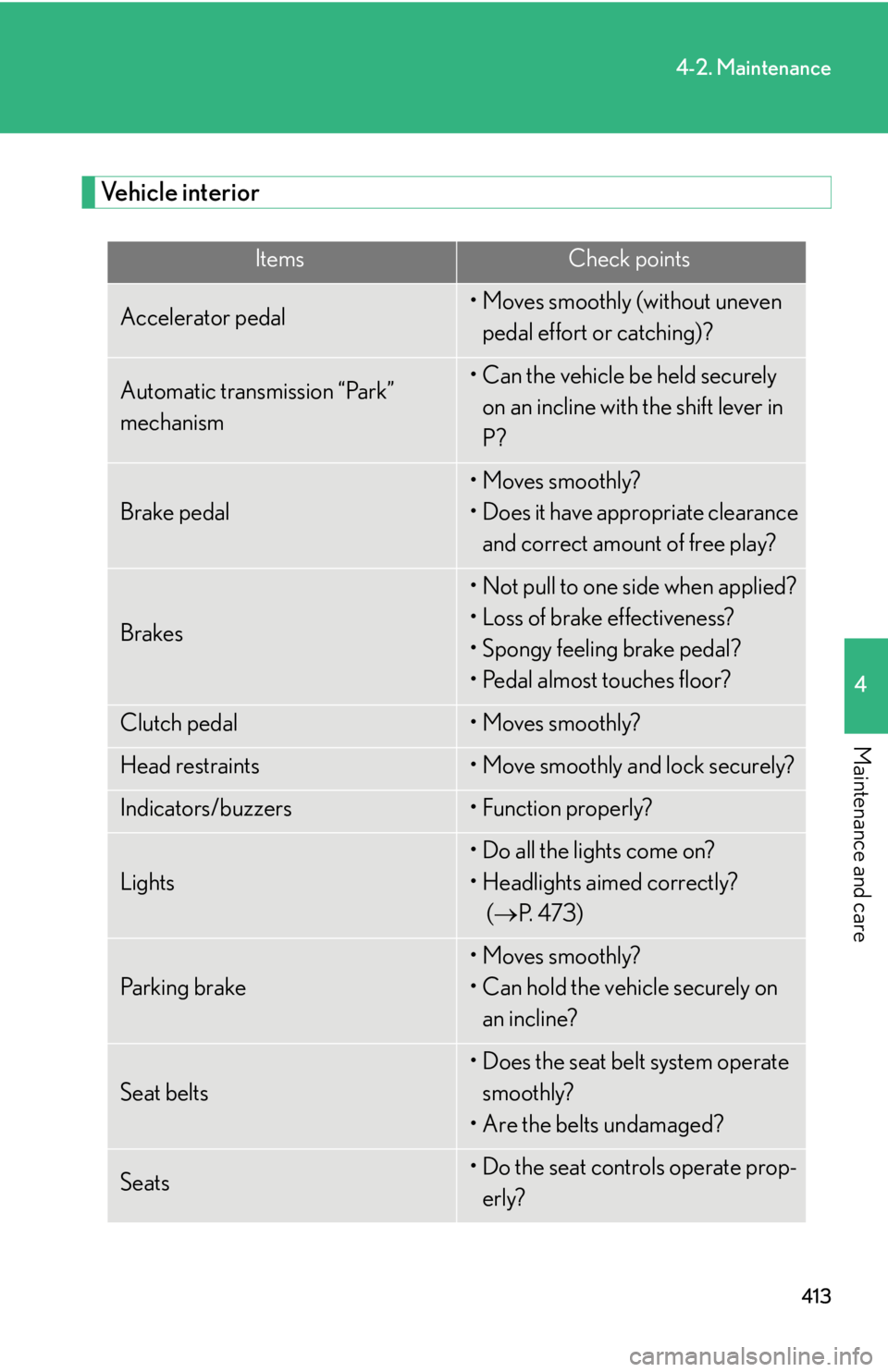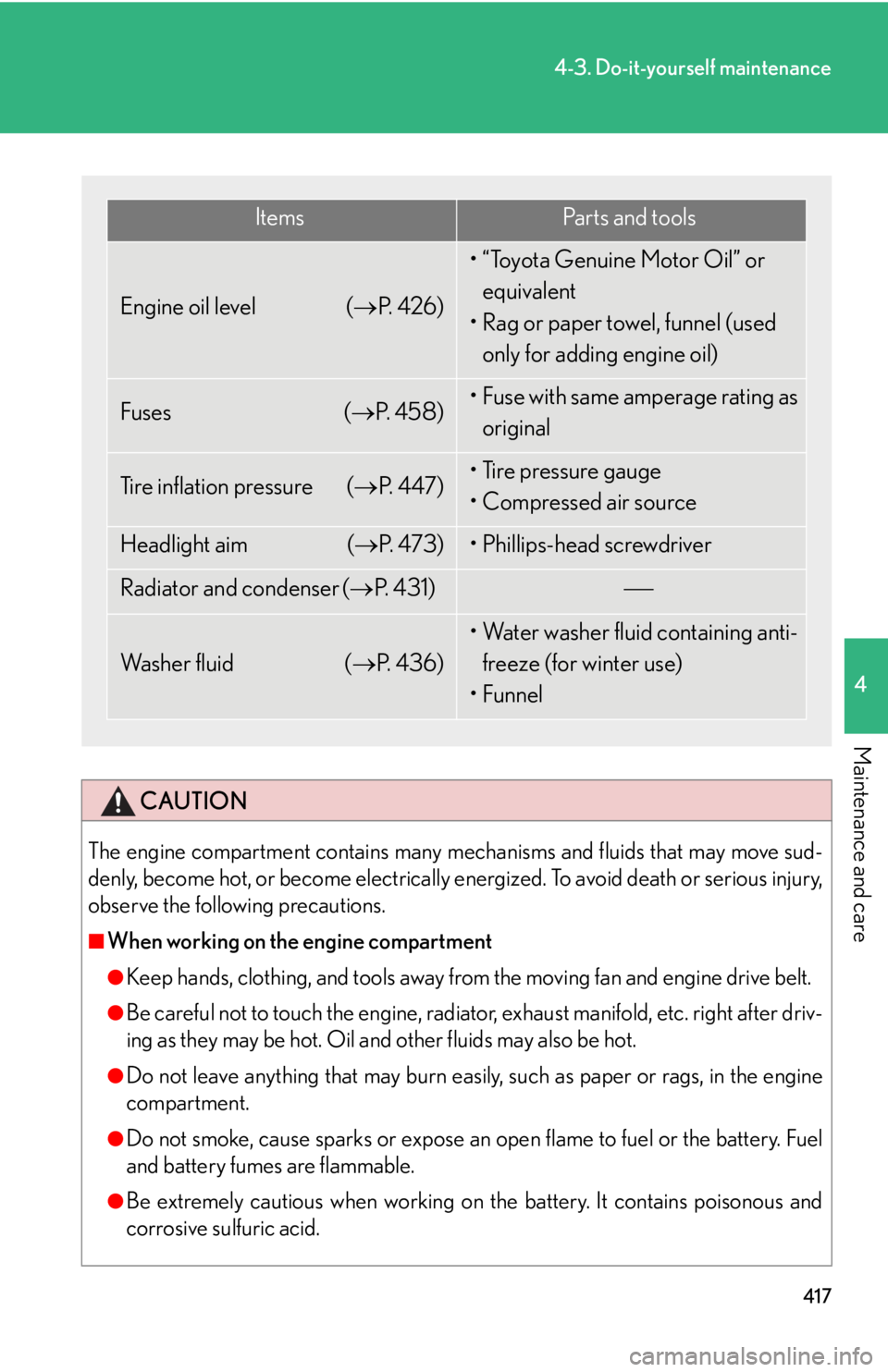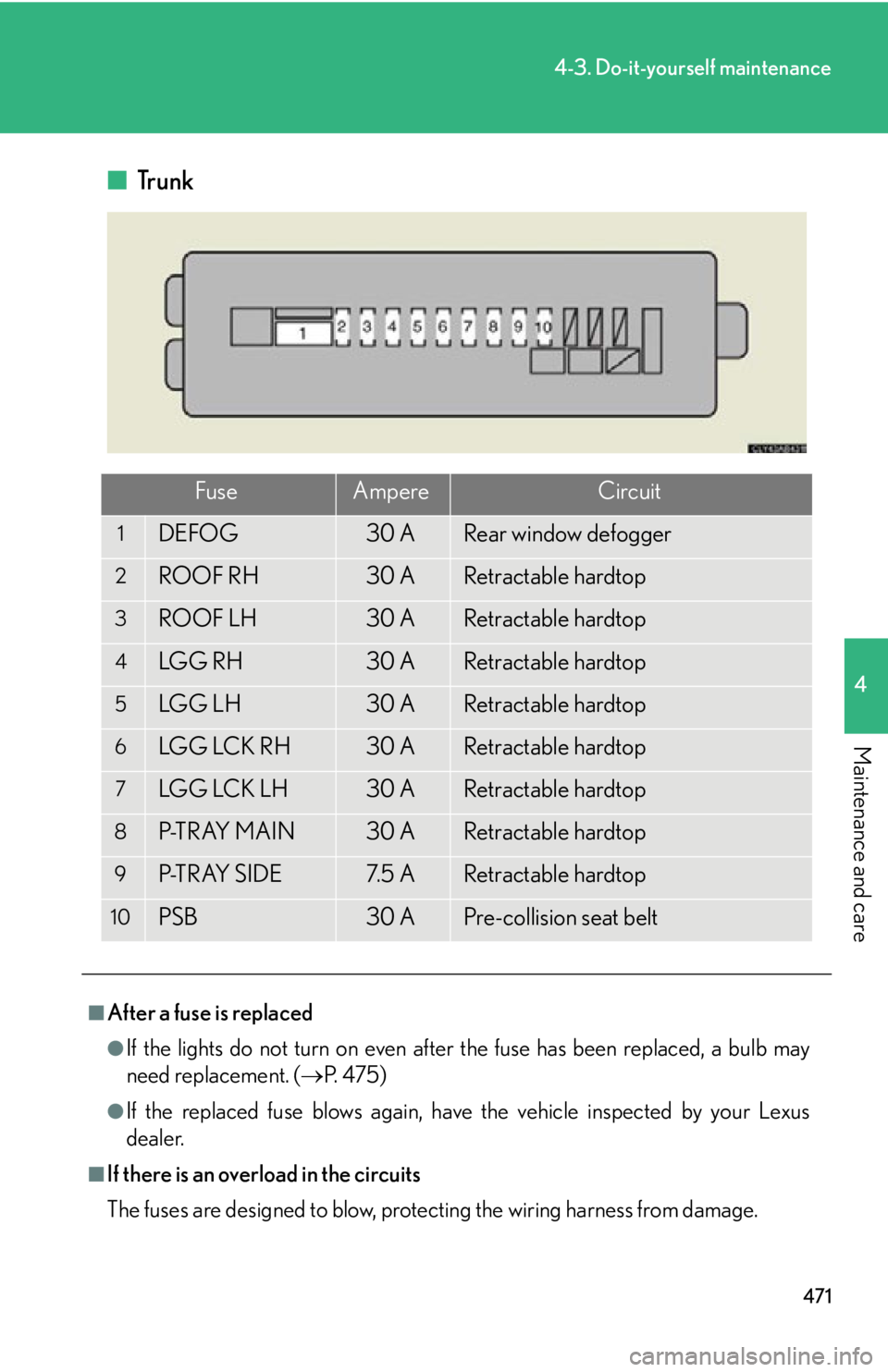belt Lexus IS250C 2012 Instrument cluster / LEXUS 2012 IS250C,IS350C (OM53A62U) Service Manual
[x] Cancel search | Manufacturer: LEXUS, Model Year: 2012, Model line: IS250C, Model: Lexus IS250C 2012Pages: 632, PDF Size: 6.77 MB
Page 229 of 632

229
2-4. Using other driving systems
2
When driving
■The pre-collision system is operational when
●Pre-collision seat belt (type A)
• Vehicle speed is above 4 mph (5 km/h).
• The speed at which your vehicle is approaching the obstacle or oncomingvehicle exceeds 19 to 25 mph (30 to 40 km/h).
• The front occupants are wearing a seat belt.
●Pre-collision seat belts (type B)
• Vehicle speed exceeds 19 mph (30 km/h).
• The system detects sudd en braking or skidding.
• The front occupants are wearing a seat belt.
●Pre-collision brake Assist
• Vehicle speed is above 19 mph (30 km/h).
• The speed at which your vehicle is approaching the obstacle or the vehicle is greater than 19 to 25 mph (30 to 40 km/h).
• The brake pedal is depressed.
●Pre-collision braking:
• The pre-collision braking function is activated.
• Vehicle speed is above 10 mph (1 5 km/h).
• The relative speed difference between your vehicle and another vehicle that is forward of your vehicle, or the speed at which your vehicle is approaching
an obstacle is greater than 10 mph (1 5 km/h).
■Situations in which the pre-collision system does not function properly
The system may not function effectively in situations such as the following:
●On roads with sharp be nds or uneven surfaces
●If a vehicle suddenly moves in front of your vehicle, such as at an intersection
●If a vehicle suddenly cuts in front of your vehicle, such as when overtaking
●In inclement weather such as heav y rain, fog, snow or sand storms
●When your vehicle is skidding with the VSC system off
●When an extreme change in vehicle height occurs
●When the axis of the radar is out of adjustment
Page 230 of 632

230
2-4. Using other driving systems
■ Conditions that may trigger the system even if there is no possibility of collision
●When there is an object by the roadside at the entrance to a curve
●When passing an oncoming vehicle on a curve
●When driving over a narrow iron bridge
●When there is a metal object on the road surface
●When driving on an uneven road surface
●When passing an oncoming vehicle on a left-turn
●When your vehicle rapidly closes on the vehicle in front
●When a grade separation/interchange, sign, billboard, or other structure
appears to be directly in the vehicle’s line of travel.
●When an overhead billboard or other me tallic structure appears to be in the
vehicle’s direct line of travel due to driving on a hill.
●When an extreme change in vehicle height occurs
●When the axis of the radar is out of adjustment
●When passing through certain toll gates
●When driving on a bridge.
When the system is activated in the situations described above there is also a possi-
bility that the seat belts will retract quickly and the brakes will be applied with a force
greater than normal. When the seat belt is locked in the retracted position, stop the
vehicle in a safe place, release the seat belt and refasten.
■Automatic cancelation of the pre-collision system
When a malfunction occurs due to sensor contamination, etc. that results in the
sensors being unable to detect obstacles, the pre-collision system will be automati-
cally disabled. In this case, the system will not activate even if there is a collision pos-
sibility.
■When there is a malfunction in the system
Warning lights and/or warning messages will turn on or flash. ( P. 495, 504)
Page 408 of 632

408
4-1. Maintenance and care
■Caring for leather areas
Lexus recommends cleaning the interior of the vehicle at least twice a year to main-
tain the quality of the vehicle’s interior.
■Shampooing the carpets
There are several commercial foaming-type cleaners available. Use a sponge or
brush to apply the foam. Rub in overlapping circles. Do not apply water. Excellent
results are obtained by keeping the carpet as dry as possible.
■Seat belts
Clean with mild soap and lukewarm water using a cloth or sponge. Also check the
belts periodically for excessive wear, fraying or cuts.
CAUTION
■Water in the vehicle
●Do not splash or spill liquid in the vehicle.
Doing so may cause electrical components etc. to malfunction or catch fire.
●Do not get any of the SRS components or wiring in the vehicle interior wet.
( P. 1 0 7 )
Electrical malfunction may cause the airbag s to deploy or not function properly,
resulting in death or severe injury.
■Cleaning the interior (especially instrument panel)
Do not use polish wax or polish cleaner. The instrument panel may reflect off the
windshield, obstructing the driver's view and leading to an accident, resulting in
death or serious injury.
Page 413 of 632

413
4-2. Maintenance
4
Maintenance and care
Vehicle interior
ItemsCheck points
Accelerator pedal• Moves smoothly (without uneven pedal effort or catching)?
Automatic transmission “Park”
mechanism• Can the vehicle be held securely on an incline with the shift lever in
P?
Brake pedal
• Moves smoothly?
• Does it have appropriate clearance and correct amount of free play?
Brakes
• Not pull to one side when applied?
• Loss of brake effectiveness?
• Spongy feeling brake pedal?
• Pedal almost touches floor?
Clutch pedal• Moves smoothly?
Head restraints• Move smoothly and lock securely?
Indicators/buzzers• Function properly?
Lights
• Do all the lights come on?
• Headlights aimed correctly? ( P. 4 7 3 )
Pa r k i n g b r a ke
• Moves smoothly?
• Can hold the vehicle securely on
an incline?
Seat belts
• Does the seat belt system operate smoothly?
• Are the belts undamaged?
Seats• Do the seat controls operate prop- erly?
Page 417 of 632

417
4-3. Do-it-yourself maintenance
4
Maintenance and care
CAUTION
The engine compartment contains many mechanisms and fluids that may move sud-
denly, become hot, or become electrically energized. To avoid death or serious injury,
observe the following precautions.
■When working on the engine compartment
●Keep hands, clothing, and tools away from the moving fan and engine drive belt.
●Be careful not to touch the engine, radiator , exhaust manifold, etc. right after driv-
ing as they may be hot. Oil and other fluids may also be hot.
●Do not leave anything that may burn easi ly, such as paper or rags, in the engine
compartment.
●Do not smoke, cause sparks or expose an open flame to fuel or the battery. Fuel
and battery fumes are flammable.
●Be extremely cautious when working on the battery. It contains poisonous and
corrosive sulfuric acid.
ItemsPa r t s a n d t o o l s
Engine oil level ( P. 4 2 6 )
• “Toyota Genuine Motor Oil” or
equivalent
• Rag or paper towel, funnel (used only for adding engine oil)
Fuses ( P. 4 5 8 )• Fuse with same amperage rating as
original
Tire inflation pressure ( P. 4 4 7 )• Tire pressure gauge
• Compressed air source
Headlight aim ( P. 4 7 3 )• Phillips-head screwdriver
Radiator and condenser ( P. 4 3 1 )
Wa s h e r f l u i d ( P. 4 3 6 )
• Water washer fluid containing anti-
freeze (for winter use)
•Funnel
Page 445 of 632

445
4-3. Do-it-yourself maintenance
4
Maintenance and care
CAUTION
■Tire pressure warning system operation
The tire pressure warning system may not provide warning immediately if a tire
bursts or if sudden air leakage occurs.
■When inspecting or replacing tires
Observe the following precautions to prevent accidents. Failure to do so may cause
damage to parts of the drive train, as well as dangerous handling characteristics,
which may lead to an accident resu lting in death or serious injury.
●Do not mix tires of different makes, mode ls or tread patterns. Also, do not mix
tires of remarkably different treadwear.
●Do not use tire sizes other th an those recommended by Lexus.
●Do not mix differently constructed tires (radial, bias-belted or bias-ply tires).
●Do not mix summer, all season and winter tires.
●Do not use tires that have been used on another vehicle.
Do not use tires if you do not know how they were used previously.
■When initializing the tire pressure warning system
Do not press the satellite switch without fi rst adjusting the tire inflation pressure to
the specified level. Otherwise, the tire pressure warning light may not come on
even if the tire inflation pressure is low, or it may come on when the tire inflation
pressure is actually normal.
NOTICE
■Repairing or replacing tires, wheels, ti re pressure warning valves, transmitters
and tire valve caps
●When removing or fitting the wheels, tires or the tire pressure warning valves and
transmitters, contact your Lexus dealer as the tire pressure warning valves and
transmitters may be damage d if not handled correctly.
●When replacing tire valve caps, do not use tire valve caps other than those speci-
fied. The cap may become stuck.
Page 468 of 632

468
4-3. Do-it-yourself maintenance
10ECU-IG LH10 A
Cruise control, air conditioning sys-
tem, power steering, rain sensor, anti-
glare inside rear view mirror, shift lock
system, tire inflation pressure warning
system, vehicle stability control
11FR S/HTR LH15 ASeat heaters and ventilators, air condi-
tioning system
12FR DOOR LH20 APower windows, outside rear view
mirrors
13SECURITY7. 5 ASmart access system with push-button
start
14H-LP LVL7. 5 AAutomatic head light leveling system
15LH-IG10 A
Charging system, headlight cleaner,
rear window defogger, electric cool-
ing fans, emergency flashers, turn sig-
nal lights, back-up lights, stop lights,
mirror heaters, seat belt pretensioner,
intuitive parking assist, cruise control,
PTC heater, exhaust system, smart
access system with push-button start
16FR WIP30 AWindshield wipers
FuseAmpereCircuit
Page 470 of 632

470
4-3. Do-it-yourself maintenance
10CIG15 ACigarette lighter
11PWR OUTLET15 APo w e r o u t l e t
12FR DOOR RH20 APower windows, outside rear view
mirrors
13AM27. 5 AStarting system
14RH-IG7. 5 A
Seat belt pretensioner, intuitive park-
ing assist, automatic transmission, seat
heater and ventilator
15FR S/HTR RH15 ASeat heaters and ventilators, air condi-
tioning system
16ECU-IG RH10 A
Power seats, headlights, front fog
lights, parking lights, license plate
lights, front side marker lights, wind-
shield washer, outside rear view mir-
rors, VDIM, air conditioning system,
pre-collision seat belt, electric tilt and
telescopic steering, power windows,
navigation system, vehicle stability
control, retractable hardtop, clock
FuseAmpereCircuit
Page 471 of 632

471
4-3. Do-it-yourself maintenance
4
Maintenance and care
■ Trunk
FuseAmpereCircuit
1DEFOG30 ARear window defogger
2ROOF RH30 ARetractable hardtop
3ROOF LH30 ARetractable hardtop
4LGG RH30 ARetractable hardtop
5LGG LH30 ARetractable hardtop
6LGG LCK RH30 ARetractable hardtop
7LGG LCK LH30 ARetractable hardtop
8P-T R AY M A I N30 ARetractable hardtop
9P-T R AY S I D E7. 5 ARetractable hardtop
10PSB30 APre-collision seat belt
■After a fuse is replaced
●If the lights do not turn on even afte r the fuse has been replaced, a bulb may
need replacement. ( P. 475)
●If the replaced fuse blows again, have the vehicle inspected by your Lexus
dealer.
■If there is an overload in the circuits
The fuses are designed to blow, protecting the wiring harness from damage.
Page 496 of 632

496
5-2. Steps to take in an emergency
Have the vehicle inspected by your Lexus dealer immediately.
Failing to investigate the cause of the following warnings may lead to the
system operating abnormally and possibly cause an accident. Have the
vehicle inspected by your Lexus dealer immediately.
Warning lightWarning light/Details
(U.S.A.)
(Canada)
Malfunction indicator lamp
Indicates a malfunction in:
• The electronic engine control system;
• The electronic throttle control system; or
• The electronic automatic transmission control system.
SRS warning lightIndicates a malfunction in:
• The SRS airbag system; or
• The seat belt pretensioner system.
(U.S.A.)
(Canada)
“ABS” warning lightIndicates a malfunction in:
•The ABS;
• The brake assist system.
Electric power steering system warning light
Indicates a malfunction in the EPS (Electric Power Steering)
system.
Pre-collision system warning light (if equipped)Indicates a malfunction in the pre-collision system.
The warning light will operate as follows, even when the sys-
tem is not malfunctioning:
• The light will flash quickly wh en the system is operating.
( P. 2 2 7 )
• The light will flash when the pre-collision braking is dis- abled. ( P. 2 2 8 )
• The light will flash when the system cannot temporarily be
used. ( P. 5 0 7 )